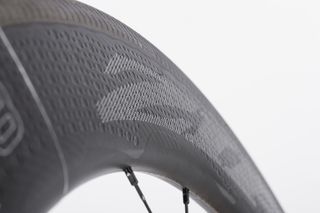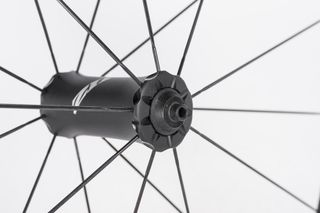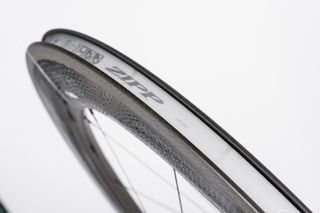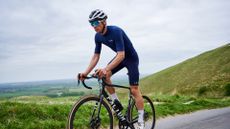Zipp 808 NSW review
We put Tony Martin's time trialling wheels of choice to the test

Absolutley rapid wheels that are regarded by many as the industry standard. Best suited to those racing triathlons or time trials.
-
+
Very aerodynamic
-
+
Aerodynamically stable - handle well in crosswinds
-
+
Looks
-
+
Width
-
+
Stiff
-
+
Well made
-
-
Not tubeless
-
-
Aero tweaks such as internal nipples could be made
You can trust Cycling Weekly.
The Zipp 808 NSW is the deepest-profile rim Zipp makes at 82mm deep, and is primarily aimed at time trial and triathlon. You can use them for road racing but most riders tend to favour a shallower profile for more all-round performance.
>>> Click here for a buyer's guide to road bike wheels
NSW is Zipp’s internal advanced design centre and stands for Nest Speed Weaponry.
'The Nest' is the nickname Zipp engineers gave to its top-secret test lab. The Zipp 808 NSW retains the 82mm depth of the 808 Firecrest but has an updated rim shape and hub design.
The new wheel has a maximum width of 27.8mm with a brake track width of 26.44 mm and the complete wheelset weighs in at 1,810g (830g front and 980g rear).

The Zipp 808 NSW is fitted with the Cognition hubs with Axial Clutch technology. This system is designed to save energy as you freewheel – every time a conventional freehub starts to coast, friction within the ratchet mechanism works like a drum brake to slow the rider down.
With Axial Clutch, the ratchet mechanism is disengaged when coasting. It then uses magnets to re-engage once the rider starts pedalling. It's a marginal gain, but one that is noticeable when doing a roll-down test on a local hill.
Each wheel includes:
• Zipp black titanium skewer
• Zipp valve extender by Silca
• Zipp individual wheel bag
• Zipp Platinum Pro Evo brake pads
• Zipp tube 700c x 19-25mm
• Zipp rim tape 700c x 20mm
As with other Zipp wheels the 808 NSW has To test the wheels I have been using them mostly in time trials.
I have tested the rear Zipp 808 NSW too while training, but for time trials I have favoured the Zipp Super 9 Disc because it offers a greater sailing effect and helps me go faster. The Zipp 808s feel very fast and are excellent at holding speed, especially when there is a slight crosswind.
http://www.instagram.com/p/BUJ5_WUjgmf/?taken-by=dr_oliverb
Prior to using the Zipp 808 I have used several other wheels while time trialling, most frequently the HED GT3 trispoke. The HED has often been regarded as the fastest wheel out there for time trials, but I have found myself going faster this year using the 808 NSW.
I believe one of the main reasons for this is the aerodynamic stability of the Zipp 808 NSW. It is noticeably easier to control in crosswinds than the HED GT3, which is much twitchier.
To put this into context, while riding the 808 on the R25/3H time trial course in South Wales I was able to stay in an aerodynamic position on the tri-bars while still pedalling on the fastest downhill section of the course. Using other wheels like the GT3, the buffeting and subsequent aerodynamic stalling of the front wheel would cause me to come off the tri-bars for fear of falling off.
Over the course of 25 miles on a gusty day, these instances of instability can really add up to a significant handful of seconds. With an internal rim width of 17.5mm, I found 23mm Continental tyres worked brilliantly, with a flush integration of tyre and wheel rim. As we know, 25mm tyres offer slightly improved rolling, but 23mm offers superior aerodynamics at time trialling speeds.

Zipp absolutely loves marketing buzzwords: the Showstopper brake track is included on these rims. It is certainly an improvement in wet and dry braking over the previous Zipp wheels and is also better than that of ENVE rims I have tested. It is, however, still a carbon clincher brake track and remains inferior to the best aluminium tracks and vastly inferior to any disc brake.
Watch - Which tyre system is fastest?
I am a competent descender and on long technical descents I did experience heat build-up, fade and squealing. I must stress that this would not put me off purchasing the 808s, though I wouldn't buy them with the intention of descending the Mortirolo. I would argue that if you are braking enough to get fade in a TT then you are doing it wrong.

Stiffness is good too – when sprinting or riding hard through corners or out the saddle I haven't experienced brake rub or flex, something I have encountered on the rear ENVE 7.8 wheel.
The Zipp 808 NSW is a brilliant wheelset, but I do have a couple of slight criticisms. Firstly, they are not tubeless compatible. Experiments have shown that tubeless tyres offer lower rolling resistance than standard clinchers and are currently being used by several top domestic time triallists. Tubeless is also a great option for long-course triathletes as it drastically reduces puncture risk.
I also believe a couple of tweaks could be made to further reduce drag. DT Swiss and Swissside have demonstrated that internal nipples can reduce rotational drag by half a watt.
This is a slight criticism as it does mean adjusting nipples and spoke tension requires removal of the rim tape and is therefore a slight trade-off. However, when you are spending over £1,000 on a wheel you want the best, and the aerodynamic difference between the best wheels on the market is small. I also believe there is scope for a more aerodynamic skewer design, perhaps with a removable lever.

Thank you for reading 20 articles this month* Join now for unlimited access
Enjoy your first month for just £1 / $1 / €1
*Read 5 free articles per month without a subscription

Join now for unlimited access
Try first month for just £1 / $1 / €1
Get The Leadout Newsletter
The latest race content, interviews, features, reviews and expert buying guides, direct to your inbox!
Oliver Bridgewood - no, Doctor Oliver Bridgewood - is a PhD Chemist who discovered a love of cycling. He enjoys racing time trials, hill climbs, road races and criteriums. During his time at Cycling Weekly, he worked predominantly within the tech team, also utilising his science background to produce insightful fitness articles, before moving to an entirely video-focused role heading up the Cycling Weekly YouTube channel, where his feature-length documentary 'Project 49' was his crowning glory.
-
 I chilled out at Liège-Bastogne-Liège U23 - and then took victory, explains British winning machine
I chilled out at Liège-Bastogne-Liège U23 - and then took victory, explains British winning machineJoe Blackmore set to make the step up to Israel-PremierTech ProTeam from the Academy next season
By James Shrubsall Published
-
 Knee pain from cycling: tips on how to fix it, from a bike fitter and osteopath
Knee pain from cycling: tips on how to fix it, from a bike fitter and osteopathKnee pain is common among cyclists - we explain some of the causes and how to address them with help from a coach, bike fitter and osteopath
By Michelle Arthurs-Brennan Published
-
 Matteo Jorgenson: I'm too tall to win a Grand Tour
Matteo Jorgenson: I'm too tall to win a Grand TourAmerican rules himself out of being a three-week option for Visma-Lease a Bike
By Tom Davidson Published